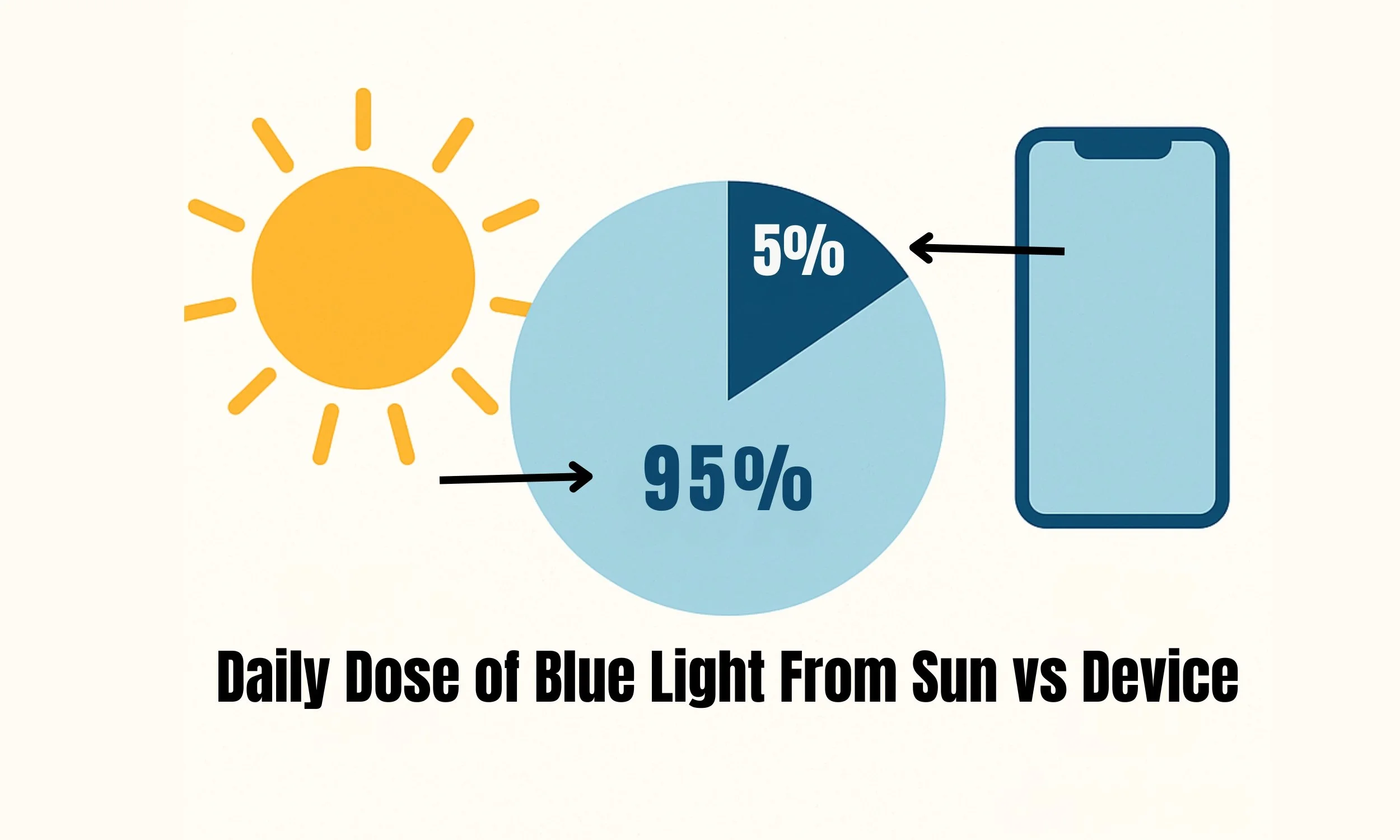Does Blue Light Really Age Your Skin? The Truth About Screens and Skin Damage
This post contains affiliate links. As an Amazon Associate, I earn from qualifying purchases—at no extra cost to you. I only recommend products I truly believe in.
Wait—Your Phone Might Be Aging You?
Let’s play a quick game of skincare paranoia: your phone buzzes, you pick it up, and boom—tiny invisible rays start sneakily sabotaging your collagen. Cute, right?
Welcome to the blue light panic.
You’ve probably heard the whispers (or loud TikTok voiceovers): “Blue light from screens causes wrinkles!” “It’s worse than UV!” “You need blue light skincare NOW or your face will melt!” Okay, maybe not melt—but the fear is real. And confusing. Especially when you’re just trying to scroll memes and mind your SPF.
But here’s the thing: there’s actual science behind the blue light convo. It’s not just influencer fear-mongering. Blue light does affect your skin—but not in the apocalyptic way your For You Page might suggest. The truth lies somewhere between “lol it’s fine” and “buy this $120 serum or suffer.”
So if you’ve been wondering whether your screen time is sneakily speeding up your skin aging—or if that 8-hour Zoom marathon actually explains your dull, tired look—I’ve got you.
We’re breaking down what blue light actually is, what peer-reviewed research says (not Karen from Facebook), and how to defend your glow without deleting Instagram or investing in SPF made by NASA.
Time to science-up, glow-up, and screen-proof your face.
💡 WTF Is Blue Light, Really?
Okay, before we go full skincare-defense-mode, let’s get clear on what blue light actually is—because no, it’s not just the glow from your doomscrolling at 1:00 a.m.
Blue light = high-energy visible (HEV) light, a part of the visible spectrum between 400–500 nanometers. In human terms? It’s the cool-toned glow your phone, laptop, and LED bulbs blast at your face all day long.
Also? The sun beams out way more of it than your phone ever could. So if the sun is the Beyoncé of blue light, your iPhone is... maybe a backup dancer in the chorus.
So why does it matter for your face?
Because research shows blue light can:
⚡ Trigger oxidative stress (aka cell damage)
🧬 Disrupt collagen by activating matrix metalloproteinases (MMPs)
🌑 Worsen hyperpigmentation in deeper skin tones
No, it’s not going to melt your face. But it’s not doing your glow any favors either.
TL;DR: Your screens are sneakily dosing your skin with stress all day long—especially if your screen time is clocking in like a full-time job.
😬 So, Should You Panic? Or Nah?
Let’s keep it real: yes, blue light can stress out your skin in a lab setting—but you’re not sitting under a laser beam while checking your email.
Most of the scary studies?
They use intense, concentrated light—way more than your phone or laptop dishes out. Unless you’re sitting in front of a grow light for 8 hours a day, your face isn’t spontaneously aging.
But if you’re glued to a screen all day (hi 👋), and skipping antioxidants or SPF?
That exposure can build up. Think of it like light pollution for your skin—not a catastrophe, but not ideal either.
Bonus fact:
Natural sunlight blasts out way more blue light than your phone. So if you’re camped out by a sunny window, your TikTok habit isn’t the main problem.
No, don’t panic.
Yes, prep smart.
Prevention is cheaper than reversing damage—and your future face will thank you.
🛡️ How to Protect Your Glow from Blue Light (Without Losing Your Mind)
So now that we know blue light isn’t total skincare fiction—but also not apocalypse-level scary—let’s talk defense. Here’s how to shield your glow without going full vampire mode.
☀️ 1. Use Sunscreen with Iron Oxides
Not all SPF is created equal.
Regular sunscreen blocks UV. But blue light? You need the tinted, mineral kind with iron oxides—especially if you’re prone to hyperpigmentation.
Top Picks:
- La Roche-Posay Anthelios Tinted SPF 50
Lightweight, non-greasy, and backed by derms and data.
👉 Check price on Amazon - EltaMD UV Daily Tinted SPF 40
Hydrating, tinted, and packed with niacinamide—your barrier will thank you.
👉 Check price on Amazon
Use it every morning—even if you’re “just inside.” Especially if your desk is near a window.
🧴 2. Add Antioxidants to Your Routine
This is your skin’s daily damage-control squad.
Antioxidants help neutralize oxidative stress and support collagen—especially when paired with SPF.
Look for:
- Vitamin C
- Vitamin E
- Ferulic Acid
- Green tea extract
- Niacinamide
Product Recs:
- Obagi Professional-C Serum 20%
Potent L-ascorbic acid formula, great for glow and firmness.
👉 Check price on Amazon - Drunk Elephant C-Firma Fresh
A punchy antioxidant blend with serious glow potential.
👉 Check price on Amazon - Allies of Skin 35% Vitamin C Perfecting Serum
Potent, silky, and ideal for brightening without irritation.
👉 Check price on Amazon
💡 3. Cut Back on Constant Exposure
You don’t need to delete the apps—but you can glow smarter.
- Turn on Night Shift or warm screen filters
- Sit at least 12 inches from your screen
- Log off an hour before bed (your skin and sleep will high-five you)
📣 Your skin isn’t anti-screen. But it loves smart habits, good SPF, and a little antioxidant backup. Glow defense mode = activated.
🧴 Your Glow-Protecting AM/PM Routine
You don’t need a 12-step Korean routine or a PhD in photobiology to protect your skin from blue light. Here’s what your day-to-night lineup should actually look like—science-backed, sass-approved.
🌞 Morning Routine: Glow Armor Activated
Step 1: Gentle Cleanser
Clean off the night but don’t strip your barrier. Foaming face washes that leave you squeaky? A crime.
Step 2: Antioxidant Serum
This is your free-radical-fighting superhero. Vitamin C, niacinamide, or green tea extract—pick your power.
Step 3: Tinted Mineral SPF
Your must-have. Blocks UV and blue light when it includes iron oxides. You need it even if you WFH.
👉 I use this one from La Roche-Posay—lightweight, glowy, not ghosty.
Optional Step 4: Barrier Cream
If your skin’s feeling tight or dry, seal the deal with a lightweight moisturizer. Think ceramides or peptides—not a thick slug.
🌙 Night Routine: Repair + Recharge
Step 1: Cleanser (Again)
Yes, you need to wash off sunscreen and screen grime. Double cleanse if you wear makeup or SPF layers thick enough to stop a laser.
Step 2: Retinoid or Peptide Serum
Now’s the time to kickstart collagen and cell turnover. Retinoids do the heavy lifting, peptides if your skin needs TLC.
👉 This 1% retinol from Paula’s Choice is powerful, gentle-ish, and glow-up approved.
Step 3: Antioxidant or Barrier Serum
Hydrating, calming, and recovery-ready. Think hyaluronic acid, panthenol, or ectoin.
Step 4: Moisturizer or Face Oil
Lock it in. Your skin just worked overtime—tuck it in with a comfy blanket of nourishment.
✨ Final Takeaway: Screens Are Here to Stay—But So Is Your Glow
Blue light isn’t the end of the world—or your face. But research shows it can mess with collagen, pigmentation, and your skin’s repair mode over time. The good news? You don’t need to live in the dark or spend your life savings on skincare to fight it.
A good routine = smart sunscreen, antioxidant armor, and habits that support your barrier (and your sanity).
Your screen isn’t going anywhere. But now? You’ve got the science to protect your glow like a pro.
Want to Dig Deeper?
For a complete plan beyond SPF, this routine guide shows how to stack protection and repair.
Antioxidants can help handle everyday exposure, so choose a vitamin C that’s proven to perform.
If you’d rather not sift through dozens of products, this quick shortlist makes morning antioxidants easy.
📚 References
- Liebel F, Kaur S, Ruvolo E, Kollias N, Southall MD. Irradiation of skin with visible light induces reactive oxygen species and matrix metalloproteinase expression. J Invest Dermatol. 2012 Jul;132(7):1901-7. doi:10.1038/jid.2011.476
- Cooper KD. Cellular and molecular biology of human skin response to solar ultraviolet radiation. Photochem Photobiol. 1996 Jun;63(6):669–676. doi:10.1111/j.1751-1097.1996.tb03023.x
- Duteil L, Cardot-Leccia N, Maubert Y, et al. Specific effects of visible light on skin pigmentation: comparative clinical study vs UVA. J Invest Dermatol. 2014 Feb;134(2):532–534. doi:10.1038/jid.2013.437
- Opländer C, et al. Blue light causes oxidative stress and induces DNA damage in human keratinocytes. Free Radic Biol Med. 2011 Aug;51(6):1287–1295. doi:10.1016/j.freeradbiomed.2011.06.002
- Hughes H, et al. Iron oxide pigments in tinted sunscreens provide protection against visible light-induced pigmentation in skin of color. J Drugs Dermatol. 2020 Jun;19(6):585–590.
- Pérez-Sánchez A, et al. Protective effect of antioxidants against skin oxidative damage. Curr Drug Metab. 2018;19(9):729–738. doi:10.2174/1389200219666180919153143
- Zastrow L, et al. The missing link—light-induced (280–1600 nm) free radical formation in human skin. Skin Pharmacol Physiol. 2009;22(1):31–44. doi:10.1159/000178874
- Aust AE, Eveleigh JF. Mechanisms of UV-induced reactive oxygen species formation and cellular damage. In: Free Radicals and Aging. Springer, 1999.
- Navarrete de Gálvez E, Aguilera J, Solis A, de Gálvez MV, de Andrés JR, Herrera-Ceballos E, Gago-Calderon A. The potential role of UV and blue light from the sun, artificial lighting, and electronic devices in melanogenesis and oxidative stress. J Photochem Photobiol B. 2022;235:112405.


